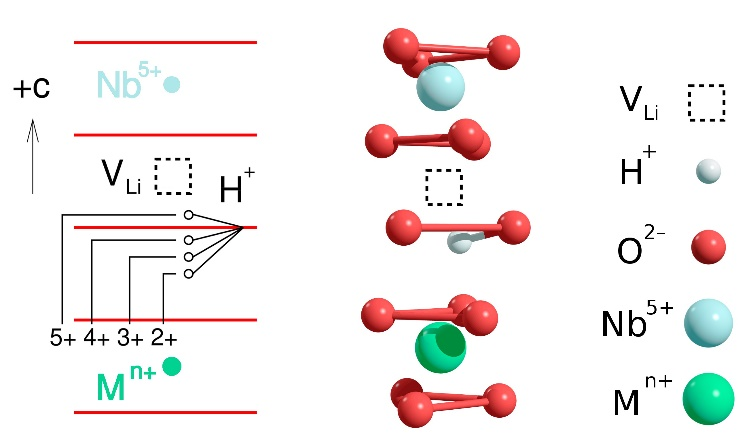2019
LiNbO3 nanocrystals. — The particle and grain size of lithium niobate nanocrystals prepared by ball-milling have been characterized by dynamic light scattering and powder X-ray diffraction methods . Milling resulted in sample darkening due to mechanochemical reduction of Nb(V) via polaron and bipolaron formation, oxygen release and Li2O segregation, while subsequent oxidizing heat-treatments recovered the white color with the evaporation of Li2O and crystallization of a LiNb3O8 phase instead. Raman spectroscopy, X-ray diffraction, optical reflection measurements and coulometric titration have been used to follow the phase transformations occurring during both the grinding and the post-grinding heat treatments.
Hydroxyl ions in LiNbO3 single crystals. — Vibrational bands of hydroxyl ions (OH-) have been observed in stoichiometric LiNbO3 (sLN) single crystals for transition metal ion (Fe3+, Cr3+, Ti4+) dopants above a threshold concentration, and attributed to the stretching vibration of OH- ions in  – OH type complexes, where the dopant M occupies a Nb site . The observed vibrational frequencies of the OH- ions and their polarization dependences agree well with the model established earlier for LiNbO3 doped with optical damage resistant and rare-earth ions, confirming its general validity (see Fig. 1). Hydroxyl ions are the most convenient probes for the detection of the change of any dopant incorporation from Li to Nb site at the threshold concentration
– OH type complexes, where the dopant M occupies a Nb site . The observed vibrational frequencies of the OH- ions and their polarization dependences agree well with the model established earlier for LiNbO3 doped with optical damage resistant and rare-earth ions, confirming its general validity (see Fig. 1). Hydroxyl ions are the most convenient probes for the detection of the change of any dopant incorporation from Li to Nb site at the threshold concentration

Figure 1. Schematic drawing of the OH- location in Mn+- doped sLN crystals.
Laser-pulse induced optical transients in LiNbO3. — While fast transient near IR absorption in LiNbO3 is due to polaron decay, photoluminescence processes in Mg-doped LiNbO3 observed in three different time domains could be identified to correspond to various excitonic species, i) mobile or frozen-in self-trapped excitons emitting on the microsecond scale, ii) excitons trapped on charge-compensated complexes of NbLi antisites and decaying on the nanosecond scale, and iii) excitons pinned on charge-compensated dipolar complexes formed by Mg dopants yielding transients on the second scale . Similar or even longer transients of the absorption in the blue range in Mg or Fe doped LiNbO3 have also been assigned to pinned excitons, attributing the exorbitant lifetimes to the defect-pinned outstretched excitonic structure. Pinned excitons have been shown to form via hopping of self-trapped excitons or by their direct generation at dipolar defects. Absorption bands observed earlier in the UV-edge region can accordingly be assigned to direct pinned-exciton generation on dipolar defects. Polaronic and excitonic hopping-pinning scenarios together allow for a coherent explanation of all optical transients with relevance for a large class of complex systems.

Figure 2. Hopping of polarons (a) and self-trapped excitons (b) in LiNbO3. Both processes are essentially defined by the hopping of the electron between Nb sites since the additional hole constituent of the exciton moving in a close-packed oxygen sublattice has a larger mobility.
Spectroscopy of lithium yttrium orthoborate (Li6Y(BO3)3, LYB) single crystals. — Emission bands of Dy3+ impurity excited by an energy transfer upconversion (ETU) process via neighboring Yb3+ ions were revealed in the luminescence spectra of LYB:Yb(20mo%) using continuous infrared laser excitation. A theoretical model based on the saturation absorption effect was developed and successfully applied (Fig. 3) to describe the intensity and temperature dependencies of the cooperative luminescence (CL) of Yb3+ pairs in the same crystal. The temperature dependence of the obtained saturation intensity parameter shows good agreement with previous independent calculations in the literature.

Figure 3. Simultaneous fitting to the power dependence of integrated CL intensity of the Yb3+-pairs measured at different temperatures in a 20 mol% Yb-doped LYB crystal using continuous wave laser excitation at a wavelength of 972 nm.
Time-resolved luminescence spectroscopy of Tm-Yb co-doped LYB single crystals and nanocrystals. — The energy levels of Tm3+ ions in Li6Y(BO3)3 grown by the Czochralski method have been determined by absorption and luminescence spectroscopy. In Tm and Yb co-doped crystals an energy transfer process from the excited Yb3+ to the Tm3+ ions has been observed. Both Tm and Yb co-doped LYB single crystals and NaYF4 nanocrystals have been investigated with a time-resolved luminescence spectroscopy setup consisting of a tunable external-cavity IR diode laser, an acousto-optical modulator, a low-pass filter, a monochromator and a single-photon counter. For both samples, a second order intensity dependence of the saturation luminescence intensity has been found at 800 nm, indicating a two-photon excitation process. Further investigations for the interpretation of the qualitatively different pump intensity dependences of the time parameters found for these two materials, and the assessment of similar crystals as possible single-photon sources are in progress.
Designing and building a confocal microscope. — After the construction of the mechanical backbone of a new confocal microscope last year, this year optical components were assembled for laser excitation and the detection of photons emitted from a single-photon source. As a significant step forward the computer control of the microscope has been achieved by using the LabVIEW software.
Analytical methods for environmental, biological and advanced materials. — Electric IR-heating systems operated in wooden and stone churches have been shown to produce an uneven air pollutant and water vapor distribution indoors due to ventilation induced by warm air, which can have a detrimental effect on the displayed works of art . New atomic spectrometric methods for Cd quantitation in cells of various living forms were developed and applied to study the transporter function of the ABCB6 protein playing an important role in Cd detoxification . An electrolyte cathode atmospheric glow discharge operated in water vapor atmosphere has been built and studied for on-line, optical emission monitoring of elements present in natural water sediments. Spectral interferences were suppressed and signal-to-noise ratios for several elements have been improved.



